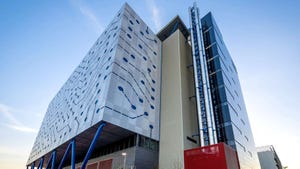
Insight and analysis on the data center space from industry thought leaders.
Tackling Data Center Hot Spots With Next-Generation Cooling TechnologiesTackling Data Center Hot Spots With Next-Generation Cooling Technologies
Next-gen cooling technologies like thermal destratification can tackle data center hot spots, enhancing efficiency and safeguarding data, writes Richard Halsall.
October 8, 2024

We’re all too familiar with the unique challenges data centers face when compared to other types of structures, residential and commercial alike. After all, we’re dealing with precious cargo, valuable data, and computing infrastructures, and carefully housing processing, distribution, IT operations, and, quite critically, backup and recovery.
Scalability and redundancy are the hallmarks of data centers, and with this, company IT and general operators rely on their strength to protect their data.
It's no surprise then when a hot spot is generated within a data center – typically due to poor air circulation in a localized area that begins to dangerously accumulate – there is the potential to destroy data and upend IT processes that any company, regardless of size or sector, could struggle with coming back from.
However, there is a light at the end of the tunnel due to breakthrough cooling technologies that not only eliminate hot spots but negate their formation altogether. With these technologies, data center operators and the companies they support can rest easier, knowing that their data and IT processes are in a stable environment – as well as providing a higher level of energy efficiency.
Hot Spots Wreak Havoc in the Data Center
Unfortunately, the bulk of existing cooling technologies are considerably more reactive in nature than proactive. Thermal management of data centers is increasingly flawed, relying on hot spot monitoring by heat sensors positioned at the tops of racks and equipment, and when alerted, data center managers literally open doors to increase circulation and ventilation around enclosures, even tapping into portable fans.
When these “solutions” don’t work, data centers and the data protected are suddenly in a very serious situation. Hot spots improperly managed can result in the following:
Substantial reduction in reliability can cause full system failures
Increased downtime that affects access to the data housed
Damage to routers, switches, storage systems, servers, and other equipment
Wasted energy usage in trying to target hotspots, resulting in a lack of energy efficiency
Increased cooling costs are especially concerning when multiple cooling solutions run in tandem, causing too much airflow in the data center, and ultimately turning into hot spots.
Bright Future vs. Past Regret
Luckily, the issues associated with traditional methods of cooling in the data center environment are being recognized, which is evident in substantial projected growth: 2023 reporting a projected market size valued at $15.16 billion, to grow to $16.84 billion in 2024, to $42.48 billion by 2032, exhibiting a CAGR of 12.3% during the forecast period.
Much of this comes from a desire to embrace more energy-efficient cooling technologies, and among these is one that leverages a straightforward and proactive approach to sustaining proper data center operations.
Thermal destratification is a unique process in which mixing air in a data center (as well as other structures, especially those involved in mission-critical applications) is utilized to balance indoor temperatures and eliminate temperature layers properly. This starkly contrasts thermal stratification, which is the layering of differing air temperatures from floor to ceiling. It is essentially driven by hot air rising to the ceiling because it is lighter than the surrounding cooler air. This natural physical process has the cooler air sinking to the floor as the warmer air rises to the ceiling.
Through thermal destratification, data centers can avoid the potential for disruptive hot spots to dramatically affect operations and allow them to safeguard the data and IT processes that are the backbone of business. Thermal destratification allows for the reduction in blower speed to achieve full saturation of HVAC air to all corners of the center, ultimately resulting in more cost-friendly energy bills.
Thermal destratification can and will reduce the temperature difference between the roof and the outside, reducing the amount of heat lost through the roof.
Partners Through Advocacy
In the business world, data centers essentially serve as partners, ensuring leaders can focus on larger issues – such as growth and increased revenue – and not the safety of their data. They should feel comfortable that their data and IT processes are in good hands and that the data centers that house them are tapping into the latest technologies versus methods that are centered around the volume and force of HVAC air output.
That full solution set eludes data centers with reliance on brute force to overcome the natural results of thermal stratification. Additionally, as indicated by an independent study recently performed by Purdue University, the benefits of thermal destratification and its use in more novel cooling approaches transform how data centers should approach cooling, especially with the continued interest in moving toward with operational consistency and the benefits of energy efficiency.
Richard Halsall is CEO of Exhale Fans.
About the Author
You May Also Like









